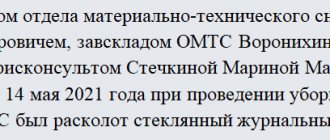Concept of hypothesis
A hypothesis must be understood as a component of a legal norm that reveals the circumstances in the absence or presence of which this article takes place. In other words, indications of certain life conditions in accordance with which it is valid are relevant.
When considering an example of a hypothesis, it is important to note that it does not exist in criminal law. Thus, the category is replaced by the provision of Article 8 of the Criminal Code in force in the Russian Federation, entitled “Grounds of criminal liability”. The cause of liability is the commission of an act that contains all the characteristics of a criminal operation provided for by this Code.
Special part of the criminal code
The Criminal Code is divided into:
The concepts of types of dispositions in criminal law exist such as:
- Simple disposition: the name of the crime, without indicating its content.
- Descriptive disposition: in addition to naming the type of crime, it also indicates the characteristics of the criminal act.
- Reference disposition: (speaks for itself) refers to another article of this code.
- Blanket disposition: (also reference), in contrast to the reference one, this type of disposition refers to another legal act of the Russian Federation (administrative, labor, civil codes or other types of legislative acts of the Russian Federation, constituent entities of the Russian Federation).
- Mixed disposition: not all authors of legal literature highlight this type of disposition, however, in practice it occurs.
Hypothesis, disposition, sanction. Examples
It is advisable to consider another situation in which all three categories are reflected. It is from it that we will get examples of hypothesis, sanction and disposition. So, Article 20.1 of the Code of Administrative Offenses of the Russian Federation, the content of which is related to petty hooliganism, reads: “Petty hooliganism, that is, a violation of order in society, expressing clear disrespect for it, accompanied by obscene language in public places, an insulting attitude towards citizens, as well as damage or destruction of someone else’s property shall entail the imposition of an administrative fine in the amount of 500 to 1000 rubles or administrative arrest for up to 15 days.”
Hypothesis, disposition, sanction in law - examples of them can be easily found in the presented provision. In other words, all three components of the structure of the rule of law are present here. Thus, the hypothesis of this legal norm points to certain factors and circumstances. If present, the actions performed by the subject may be considered petty hooliganism. An example of a hypothesis is the commission of the listed acts in public places when they do not entail the use of criminal punishment.
You need to know that the disposition of this norm is, first of all, to prohibit specific actions, in particular, obscene language, offensive harassment of citizens or other actions. Finally, this article also contains a direct reference to certain adverse consequences (arrest or administrative fine) that occur for the person who committed actions prohibited by law.
So, we have looked at examples of hypothesis, disposition and sanctions in the norm of the Code of Administrative Offenses. It is advisable to move on to analyzing these categories in accordance with the Criminal Code in force on the territory of the Russian Federation.
One more step
The classical structure of a legal norm has three parts:
The peculiarity of the Criminal Code of the Russian Federation is the delimitation of the set of parts of the article into the General and Special Parts. But, a caveat should be made here. If hypotheses are actively used for the first part, then the second part is replete with dispositions and sanctions. Unfortunately, there is no clear opinion on this issue. Some indicate that the Special Part of the Criminal Code contains all three varieties.
- Absolute - indicates a specific type and strictly defined amount of punishment.
Hypothesis, sanction and disposition in the Criminal Code of the Russian Federation
Let us highlight examples of hypothesis, disposition and sanctions in Art. 105, 106 of the Criminal Code of the Russian Federation. Murder, in other words, causing the death of another person intentionally, is usually punishable by imprisonment. The term ranges from 8 to 20 years. The category of murder may contain the following components (circumstances):
- Murder of two or more persons.
- A person or his relatives due to his (their) official work or performance of duty to society.
- A minor or another person who is obviously in a helpless state for the perpetrator. Equally, murder is considered here, which involves the kidnapping of a citizen.
- Women, when the perpetrator knows that she is pregnant.
- A murder carried out with a particular degree of cruelty.
- Committed in a manner dangerous to society.
- Murder in accordance with the motive of blood feud.
- Committed by a group of persons, a group of persons by prior conspiracy, or an organized group.
- For hire or for mercenary reasons, as well as murder, which is associated with robbery, banditry or extortion.
- For hooligan reasons.
- Murder with the aim of concealing another crime or to some extent facilitating its implementation, as well as involving sexual violence or rape.
- Based on racial, religious, political, ideological or national hostility or hatred.
- For the purpose of using tissues or organs of the victim.
In all of these cases, the punishment provides for restriction of freedom for a period of 8 to 20 years with imprisonment for a period of 1 to 2 years. In some situations, life imprisonment or the death penalty occurs.
So, let's figure it out. In accordance with the theory of criminal law, articles (rules of law) are classified into parts: hypothesis, disposition and sanction. In this case, the hypothesis should be understood as the title of the article itself. An example of a hypothesis is the word “murder,” which needs to be given a concept and deciphered. Disposition is nothing more than the content of this term (it is worth noting that it is given in Part 1 of Article 105). The sanction should be considered what the perpetrator will receive for this murder.
It is important to note that in almost all articles of Special. parts of the Criminal Code, in particular, in the given articles 105 and 106 examples of legal hypothesis and disposition are merged. They cannot be separated. The concept of murder of two or more persons, as well as murder carried out with particular cruelty - these categories represent both a disposition and a hypothesis. The exception is Art. 331 of the Criminal Code of the Russian Federation. It is not divided into disposition and hypothesis, since it contains the concept of offenses, crimes against military service. Thus, in the above articles it is almost impossible to distinguish disposition and hypothesis. By sanction it is necessary to understand the measure of punishment provided for in these articles.
Types of dispositions
Today there are several criteria for classifying the concept. The main ones are listed below.
By the nature of the regulatory impact
There are three types of dispositions: permissive, prescriptive, and prohibitive.
The former give members of society rights that can be exercised at their own discretion. For example, it follows from the Constitution that every person has the right to choose his place of residence.
Prescriptive dispositions indicate a person's duties. For example, the Constitution of the Russian Federation states that all persons must take care to preserve the historical and cultural heritage of the country.
Prohibiting dispositions indicate the inadmissibility of committing certain acts. Most of them are contained in administrative tort and criminal law.
By way of description
Here, jurists have in mind the way of describing the signs of an act. According to this criterion, there are 4 types of dispositions :
- Simple. The signs of the act are obvious from the text of the norm itself and do not require additional explanation. For example, the Code of Administrative Offenses of the Russian Federation establishes penalties for the provision of traditional healing services.
- Descriptive. The content of the act is revealed in the same norm where there is an instruction. Thus, Part 1 of Article 159 of the Criminal Code of the Russian Federation lists the signs of fraud: 1) theft or acquisition of the right to someone else’s property, 2) through deception or abuse of trust.
- Referential. The signs of the act are described in the same normative document, but in different rules of law. For example, Part 3 of Article 131 of the Criminal Code of the Russian Federation deals with the rape of a minor. And the essence of the crime itself is revealed in part 1 of the same article.
- Blanket. They refer the subject to the norms of other acts of legislation. For example, Article 15.3 of the Code of Administrative Offenses of the Russian Federation talks about failure to comply with the deadline for applying to the tax authority for registration. But the period itself is indicated in another document - the Tax Code of the Russian Federation (General Part).
By composition
Composition is the number of behavioral models available to a subject. According to this criterion, dispositions are divided into three types: simple, complex and alternative.
In the first case, a person can choose one option. For example, according to Article 10 of the RF IC, marriage relations are registered only in the civil registry office.
Complex dispositions contain 2 or more behavior patterns. As a rule, they are also binding.
For example, according to Part 4 of Article 111 of the Constitution of the Russian Federation, after the State Duma has rejected candidates for the post of Chairman of the Government three times, the President performs three actions:
- appoints the Chairman himself;
- dissolves the lower house of Parliament;
- calls new elections.
An alternative disposition provides the subject with a choice. A simple example is maintaining a premarital surname or switching to the spouse’s surname.
Definition of categories in Art. 211 Civil Code of the Russian Federation
And finally, let's look at an example of a hypothesis in Article 211 of the Civil Code in force on the territory of the Federation. Here the risk of accidental damage or accidental loss of property is a hypothesis. It is the owner who bears it, unless other rules are provided for by the contract or law (this is already a disposition). A legal norm (in other words, a rule of law) should be understood as a generally binding command, which is expressed in the form of a state and government order. It regulates social relations, legal norms that establish a certain behavioral pattern in a specific situation.
Alternative and non-alternative dispositions of law
Depending on the variability of complex dispositions, which include two or more rules, they can be constructed as alternative or non-alternative.
Alternative dispositions are when, to implement a rule, it is enough to implement only one of the listed rights, obligations and prohibitions. Let's consider paragraph 3 of Article 32 of the Family Code: “in the event of divorce, spouses have the right to retain their common surname or restore their premarital surnames.” Here both parties have the opportunity to make their own personal choices. The hypothesis goes like this: if the parties plan to enter into a divorce agreement, then the husband and wife can keep their common surname or return their old surnames at their own request.
Non-alternative dispositions - contain several rules, and require the implementation of all of them together. Let's consider an example from clause 3 of Art. 31 IC RF. This is also a complex norm. Here we see that the performance of one duty does not relieve either spouse from the performance of subsequent, remaining duties listed below. Spouses must fulfill all the duties listed in this norm for the sake of family life.
Hypothesis, disposition and sanction in the norm of customs law
Let's consider an example of a hypothesis, disposition and sanctions in one of the articles of the EAEU Labor Code. So, let's take Art. 154 “Responsibility of persons in case of violation of the customs procedure for customs transit.”
In accordance with it, in the event of non-delivery of all commercial products placed under the customs procedure of customs transit, and documentation for it to the place of delivery of goods (this is a hypothesis), the persons specified in Article 150 of this Code are liable in accordance with the legislation of the Member State whose customs authority The release of commercial products was implemented in accordance with the customs procedure. transit (this is a disposition).
Here, an example of a simple hypothesis indicates a part of a legal norm that reveals the circumstances (conditions) in the absence or presence of which the action of this norm is possible. In other words, it contains indications of certain life conditions and circumstances. It is in accordance with them that a specific legal framework comes into effect.
The disposition here is nothing more than a component of a legal norm, which reveals the very rule of behavior, that is, the obligations and (or) rights to act or not act in a specific way. It is worth adding that the disposition indicates the obligations and rights of the parties who are participants in legal relations, emerging and implemented on the basis of the relevant norm.
Sanctions should be considered responsibility for failure to comply with dispositions. In our article it will be as follows: “For failure to fulfill obligations in the process of transporting goods by rail in accordance with the customs procedure of customs transit, the carrier, which is indicated in the first paragraph of this paragraph, is responsible in accordance with the legislation of the state for transportation through whose territory the commodity products are accepted.”
Chapter 1.3. Basic concepts of legal theory.
1.3.1. Sources of law
The concept of “legal norm” is abstract, existing in the space of other abstract concepts such as “rule of conduct” (see section 1.1.3.).
The form of existence of legal norms, so to speak, on “physical media” (clay tablets, paper, computer files,..) are laws, decrees, court decisions and other sources of law.
Sources of law
- these are acts of state bodies that establish or authorize (recognize) legal norms.
In scientific and educational literature, the following types of sources of law are usually distinguished.
- Legal custom
: a rule of behavior historically established through repeated repetition, sanctioned by the state as a generally binding rule. Most ancient legal monuments represent recorded legal customs (for example, the ancient Roman “Laws of the XII Tables”, the ancient Russian “Russian Truth”). - Legal precedent:
a specific decision in a particular case by a judicial or administrative body that becomes binding in the resolution of similar cases in the future. - Regulatory act:
a document adopted by a specially authorized state body that establishes, changes or repeals legal norms. It differs from legal custom in its special mechanism of adoption, formal and structural clarity. - Regulatory agreement:
a bilateral or multilateral agreement of legal entities containing legal norms (for example, an international legal treaty or an agreement on the formation of a federation or confederation).
Typically, a particular type of source of law predominates in a particular state. For example, in ancient states, when special bodies authorized to develop and adopt normative acts had not yet emerged, the predominant type was legal custom. The publication of special documents, which represented a set of legal customs, was perceived by contemporaries not as the actual creation
legal norms, but as a purely technical operation aimed at preserving and systematizing
already existing
legal norms.
In most modern states (except for states with a legal system of the Anglo-Saxon type - see section 1.3.XXXX.), the main form of existence of legal norms is regulations.
1.3.2. Regulatory acts
Regulatory acts are adopted by various state bodies specifically authorized to establish legal norms.
In modern states, a fairly clear and universal hierarchy of normative acts has developed, associated with the hierarchy of state bodies. When applied to normative acts, the hierarchy is designated by the concept of “legal force”
: some acts have greater legal force, that is, “more important” than others.
From this point of view, normative acts can be classified as follows (in descending order of legal force): constitution, laws, by-laws.
1. Constitution
- the fundamental law of the state.
The Constitution establishes the most fundamental issues of the organization of the state (most often also of the society of a given country).
In particular, most modern constitutions contain provisions on the following issues: the foundations of the social system, the legal status of the individual (including human rights and freedoms), the procedure for the formation and activities of the highest bodies of the state, the procedure for the adoption of laws, the territorial structure of the state.
In terms of the form of the constitution, it can be:
- A separate act (the actual Constitution of the country - for example, the Constitution of the USA, France, Russia). The first constitutions as separate documents appeared in the states of the future USA in the 70s of the 18th century. The oldest constitution of this type in force in modern states is the US Constitution of 1787. Sometimes individual issues at the constitutional level are detailed in special laws referred to in the Constitution (for example, “federal constitutional laws” in Russia, “organic laws” in France).
- A set of related acts (for example, in Finland there are 4 “organic laws”, in Sweden there are 3 “fundamental laws”, none of which is actually called a “constitution”).
- A body of legal norms contained in some historical documents or even in unwritten legal customs (Great Britain, Israel). In this case, it is more correct to speak not about the constitution as the fundamental law, but about a system of constitutional norms.
In federal states, in addition to the national Constitution, there are constitutional acts of the constituent entities of the federation, for example: Constitutions of the US states; Constitutions of republics, charters of territories, regions in the Russian Federation.
The “specialness” of the constitution as the fundamental law that determines the fundamental issues of the state and society is fixed by the special procedure for the adoption and amendment of the constitution, which differs from the procedure for the adoption and amendment of other laws of the state. The special procedure for amending the constitution is aimed at making the constitution difficult to change, which ensures the stability of the fundamental foundations of the state and society.
Some specific ways to make constitutions:
- Adoption by a qualified majority of parliament (that is, not just a majority of votes of deputies, but 2/3 or even 3/4 of the votes). This is how, for example, the Constitution of the USSR of 1977 was adopted. and Greece 1975
- Adoption by a specially convened constitutional representative body. This is how, for example, the Constitutions of Italy 1947 and Portugal 1976 were adopted.
- Adoption by referendum (direct popular vote). This is how, for example, the Constitutions of France in 1958 and Russia in 1993 were adopted.
- Granting by the monarch (the so-called “discovery”) - for example, the Constitution of Qatar, Kuwait.
Some specific ways to change the constitution:
- Qualified majority of parliament.
- Double (repeated) voting in parliament, incl. with mandatory re-elections of parliament and approval of changes by the new composition of parliament (Belgium, Finland);
- Approval of constitutional amendments adopted by the parliament by the constituent entities of the federation (for example, amendments to the constitution of the relevant countries must be approved by more than 1/2 of the states of India; 3/4 of the US states; 2/3 of the republics, territories, regions and other constituent entities of the Russian federation).
- Approval of amendments in a referendum (Switzerland).
- Amendment of the constitution by a specially convened constitutional representative body (Russia, USA).
2. Laws
— normative acts adopted by the highest legislative body (parliament) and signed by the head of state.
In modern states, there are fairly strictly established and very complex procedures for the adoption of laws, in which the following stages can be distinguished:
- Legislative initiative.
There are subjects who have the right of legislative initiative, i.e. the ability to submit bills to parliament that parliament is obliged to consider. Typically, members of parliament, the president, the government and other higher government bodies and officials have this right. Sometimes this right is granted to public organizations. Other persons wishing to introduce a bill must use their influence on the subjects of legislative initiative. - Project preparation.
Someone must write the text of the bill, coordinate it with the current law, prepare all kinds of information about the need for the bill and the consequences of its adoption or failure to pass it. Usually this is done either by those who are interested in the project, or by government or ministries, or by the deputies themselves or the parliamentary apparatus. - Discussion in parliament.
Parliaments have an internal structure: they are divided into committees, commissions and other subsets of deputies according to areas of work (for example, budget, taxes, economy, industry, defense, etc.). Bills received by parliament, after being included in the work plan, are sent to the relevant relevant committees or commissions of parliament. These bodies prepare opinions on bills, involving the government, experts, holding parliamentary hearings, surveys of the public and interested parties, etc. In this case, disagreements are resolved and various interests are taken into account. It is extremely rare that in developed parliaments a project is put to a vote that has not undergone a detailed preliminary “run-in”. In most cases, even before voting, the opinion of the main factions of parliament is clarified. Projects that are obviously “unpassable” do not reach plenary sessions of parliament. - Adoption of the law.
Usually in bicameral parliaments (see section 1.2.2.) you need to get a majority of votes in each chamber. In some countries, the chambers are equal in this sense: a bill can first be adopted by either chamber, then go to the other. If the other chamber also passes the bill, it goes to the head of state for signature. If the other chamber rejects the project or makes changes to it, a conciliation procedure is launched. In some countries, the path of a bill is more strictly established: first, the lower house must pass, then the upper house (for example, in Russia, laws are adopted by the State Duma, after which they are sent for approval to the Federation Council). Joint meetings of chambers to adopt a law (as was the case in the USSR and the RSFSR) are held very rarely in world practice. - Signing and promulgation of the law.
Constitutions usually provide that laws come into force once they are signed by the head of state and published. The right of the head of state to sign (or not sign - the right of veto) a law adopted by parliament can be both formal (European monarchies) and quite real and applied in practice (USA, Russia). Typically, constitutions establish procedures for overriding a veto by the head of state by a qualified majority vote of parliament.
At almost all stages of the legislative process there are opportunities for lobbying by persons interested in the adoption (or, conversely, in the failure) of a bill. Specific forms of lobbying are extremely varied - from soft educational work with legislators (most of whom are not experts on most bills) to tough and sometimes, to put it mildly, not very legal methods. They are fighting the latter everywhere, but have not yet won anywhere.
In federal states, in addition to federal laws, there are laws of the constituent entities of the federation. These laws are adopted on subjects within the jurisdiction of the regions - subjects of the federation (for example, the regional budget, regional taxes, regional development programs) and are valid on the territory of these regions. The procedure for accepting them is similar to that described above. For example, a law of the Moscow region is adopted by the Moscow Regional Duma and signed by the Governor of the Moscow region.
3. Regulations
- acts of the head of state and executive authorities containing legal norms: presidential decrees, government regulations, orders of ministries, decrees of governors, etc.
By-laws have their own hierarchy, corresponding to the position of the official or body that issued them in the system of state bodies.
Concluding the section on regulations, we will make three comments.
- Non-normative acts (executive and administrative decisions on specific situations, individual instructions) should be distinguished from normative acts, which in a strict legal sense are not sources of law, although they are issued by the same bodies as normative acts. Normative acts differ from non-normative acts in the following ways: 1) Addressed to an uncertain or wide circle of persons. For example, a resolution on tax benefits for all
enterprises with the participation of disabled people is a normative act; The resolution on tax benefits for the enterprise “OJSC Invalid” is not a normative act. 2) Possibility of repeated application of the act. For example, the normative act of the Criminal Code can be applied repeatedly; a decree on pardoning specific individuals or a decree on amnesty - once. There are situations when one document contains both legal norms and individual instructions. In this sense, such a document should be considered a “normative act”, but, strictly speaking, the “source of law” will be only that part of it where legal norms are established. - In some cases, regulations are adopted not by an authorized government body, but directly by the population, in a referendum. In particular, some constitutions were adopted by referendum (France 1958, Russia 1993); local taxes are established in local referendums in a number of US states; Referendums on various issues are constantly held in Switzerland. The legal force of such decisions is always higher than that of decisions of government bodies. From referendums at which specific normative acts are approved, one should distinguish consultative referendums that do not have direct legal significance and are usually held for political purposes - for example, the 1991 referendum on the preservation of the USSR or the 1993 referendum on Russian economic policy.
- About terminology. Very often, the words “laws, legislation” mean not only laws in the proper sense of the word (acts adopted by parliament), but also the entire set of regulations or even all documents on a specific issue. For example, if you open any collection like “Russian Labor Legislation”, you will find in it not only the laws themselves, but also Presidential decrees, Government resolutions, orders of the Ministry of Labor and Social Development, clarifications of the Plenum of the Supreme Court and even, possibly, joint resolutions The Central Committee of the CPSU, the Council of Ministers of the USSR and the All-Union Central Council of Trade Unions (some of them are still active). It also happens, on the contrary, that some documents that are laws in the proper sense of the word have specific names of a different type, for example: Civil Code, Labor Code.
1.3.3. Legal system
Legal system
- this is the structure of law, dividing it into its component parts from the point of view of the content of legal norms, that is, certain social relations that these norms regulate.
Legal norms can be grouped into certain sets of legal norms that regulate more or less broad areas of social relations.
In scientific and educational literature, the following hierarchy of community is usually distinguished:
- A legal norm
is an elementary, generally binding rule of behavior—a “quantum” of law, so to speak. - A legal institution
is a set of relatively isolated norms that regulate a close range of social relations (for example, the institution of elections in state law, the institution of property rights in civil law, the institution of crime in criminal law,..). - Branch of law:
a set of legal institutions (sometimes including sub-branches) regulating a homogeneous area of social relations (for example, state law, civil law, criminal law,..).
It is clear that the division of law into its component parts occurs in the abstract “space” of legal norms. There is no officially approved complete list of legal norms grouped by legal institutions and branches of law anywhere. Therefore, the specific structure of law - including a list of branches of law, a set of legal institutions - is defined differently by different authors, even for the law of a particular state in a particular period of time.
At the same time, in the scientific and educational literature, fairly universal criteria have emerged for identifying branches of law, among which the main ones are the following:
- The subject
of legal regulation is a certain, fairly broad and at the same time more or less separated from others sphere of social relations. For example, there are relationships between spouses, parents and children - hence family law; there is a relationship between the state and taxpayers regarding taxes - hence tax law; there is a relationship between employees and employers - hence labor law. - Method
- that is, ways of regulating social relations, which for some industries can be predominantly hard and closed (everything that is not directly permitted is prohibited), and for other industries - on the contrary, predominantly soft, open (everything that is not directly prohibited is permitted). For one type of object in different branches of law, different methods of legal regulation are used. For example, finance is an object of social relations both in tax law and in civil law, but tax law is structured much more strictly than civil law. - Availability of basic sources of law
For example, in Russian legislation the basic source of state law is the Constitution of Russia, civil law - the Civil Code, family law - the Family Code.
The specific system of branches for the law of specific states looks very diverse. In most states, one can distinguish state (constitutional) law, civil law, labor law, family law, and tax law. In some states, trade law, land law, and administrative law are distinguished separately. In the USSR, collective farm law and economic law were separated into separate branches.
The legal system of modern Russia is discussed in detail in the second part of this textbook.
Concluding the section on the legal system, we will make two comments.
- The concepts of “system of law”
and
“system of legislation”
do not coincide. Firstly, these are concepts from different “spaces”: the system of law - from the abstract space of legal norms; system of legislation - from a specific space of physically existing documents. Secondly, a specific normative act may contain norms of various branches of law. For example, the Federal Law “On the privatization of state property and the fundamentals of privatization of municipal property in the Russian Federation” contains norms of state and administrative law (establishes the system of privatization bodies and the competence of public authorities on privatization issues), norms of civil law (establishes the procedure for concluding privatization transactions) , labor law norms (establishes guarantees of labor relations for employees of privatized enterprises). - In addition to the branches of domestic law of a particular state, there is international law
.
It is not part of the system of any domestic law, since it is established not by an individual state, but by agreements between states. International law is usually divided into public international law
, which governs relations between states, and
private international law
, which governs relations (primarily civil law) involving foreign individuals or legal entities, or regarding objects located abroad. The sources of international law are international conventions and treaties, charters and acts of international organizations, international legal customs.
1.3.4. Structure and types of legal norms
Let us now return to the consideration of the elementary abstract concept of “legal norm”.
An ideal legal norm looks something like this: a description of the situation when it applies (for example, the taxpayer had income for the reporting year); a description of the actual rules of conduct in this situation (you need to file a tax return and pay the tax); determination of liability for failure to comply with the rule (fine for failure to file a return or for failure to pay taxes).
Accordingly, in scientific and educational literature the following structure of a legal norm is usually considered:
- Hypothesis
is a description of the conditions under which a norm operates; - Disposition
- description of the rule of behavior; - A sanction
is a measure of responsibility for violating a rule of conduct.
Similar to the non-identity of the concepts “system of law” and “system of legislation,” the concept of a legal norm is not identical, for example, to the concept of an article of law.
A variety of relationships are possible here.
A specific article of the law may contain several rules of different content.
Different structural parts of one norm may be in different articles and even in different laws. For example, in the tax return example above (as applied to Russia), the hypothesis and disposition are contained in the personal income tax law, and some sanctions are contained in the Criminal Code. Finally, individual structural parts of the norm may be formally absent altogether. For example, in the articles of the Criminal Code, from the point of view of the structure of legal norms, there are only hypotheses (specific crimes - for example: theft, murder) and sanctions (specific types of punishment - for example: imprisonment, death penalty). As for dispositions, in this case they are implied and not directly indicated (for example: “thou shalt not steal”, “thou shalt not kill”).
Therefore, we must clearly understand that when we talk about the structure of a legal norm, we are talking about some “ideal” norm in the abstract space of the legal system. Moreover, even within the framework of the theory, some structural parts of the “ideal” norm can be considered as separate norms or other parts of norms in a particular context. For example, the sanction in the above tax return example is a disposition for the tax inspector or court, which determines the extent of responsibility for the negligent taxpayer.
At the same time, the concept of “structure of a legal norm” is of great practical importance, in particular for improving what lawyers call “legal technique”. For example, the very fact of understanding that norms have hypotheses, dispositions and sanctions forces lawyers, when developing the texts of normative acts, to one way or another reflect all these components.
Legal norms can be divided into types according to various criteria.
- From the point of view of the subject of legal regulation
(the content of the norm), legal norms are divided into norms of state (constitutional), civil, criminal and other branches of law. - From the point of view of the method of legal regulation,
norms can be
empowering
(the disposition indicates rights; for example: everyone has the right to work);
obligatory
(the disposition indicates obligations; for example: “Everyone is obliged to pay legally established taxes and fees”);
prohibiting
(the disposition indicates prohibitions; for example: “Forced labor is prohibited”).
There are also norms that contain not actual rules of behavior, but definitions of concepts and principles - definitive
norms; for example: “Man, his rights and freedoms are the highest value.” - From the point of view of the source of law
(see sections 1.3.1-1.3.2), norms can be in laws, in by-laws, in court decisions, etc.
1.3.5. Legal relations. Legal facts
Legal norms established or sanctioned by the state are general rules of behavior designed to regulate certain social relations. When such relationships actually
, their participants are required to comply with the relevant legal regulations.
In this case, actual relations acquire the character of a legal relationship
- that is, by definition, a specific social relationship regulated by legal norms.
As mentioned above, not every social relationship is regulated by law. For example, the obligations to pay party dues or observe religious fasts are not legal relations (although they may, in principle, be such in totalitarian communist or religious regimes, respectively).
The legal relationship is characterized by the following elements:
- The object of the legal relationship
is what the legal relationship is about. This can be property, work and services, intangible benefits (honor, dignity, etc.), power and other objects. - Subjects of a legal relationship
are parties, participants in a legal relationship. These can be individuals, organizations (including legal entities), the state, individual state bodies and other entities. - The content of the legal relationship
consists of two interrelated elements:
subjective right
and
legal obligation
, which bind the subjects of the legal relationship.
Subjective right is the possibility of
certain behavior;
A legal duty is a corresponding obligation
to behave in a particular manner.
To illustrate the concept of elements of a legal relationship, we give specific examples.
Example 1.
Ivanov owes Petrov 100 rubles. Object of legal relationship: money. Subjects of legal relations: individuals Ivanov and Petrov. Contents of the legal relationship: Petrov has a subjective right to receive money from Ivanov; Ivanov has a corresponding legal obligation to repay the debt. In this example, one party (Ivanov) has only a legal obligation, and the other party (Petrov) has only a subjective right.
Example 2.
Ivanov entered into a car purchase and sale agreement with Auto LLC, according to which Avto LLC undertakes to sell the car to Ivanov, and Ivanov agrees to pay Auto LLC the cost of the car. Objects of legal relationship: car and money. Subjects of the legal relationship: the individual Ivanov and the legal entity Auto LLC. Contents of the legal relationship: Ivanov has a subjective right to receive a car and a legal obligation to pay money; Auto LLC has a subjective right to receive money and a legal obligation to hand over the car. In this example, the parties have mutual rights and obligations.
Example 3.
Student Sidorov received a summons from the military registration and enlistment office. Object of legal relationship: military service Subjects of legal relationship: citizen Sidorov and the state. Contents of the legal relationship: Sidorov has a legal obligation to perform military service (for starters, report to the military registration and enlistment office); the state has the subjective right to call Sidorov for military service.
In real life, legal relations can be quite complex and multi-level; especially - legal relations regarding complex objects and with a large number of participants, when a system of mutual rights and obligations of participants in the legal relationship arises. For example, in the above example about Sidorov’s conscription for military service, you can detail the object of the legal relationship and the participants in the legal relationship in as much detail as you like - in particular, separately consider the relationship between Sidorov and the military registration and enlistment office regarding the appearance at the military registration and enlistment office; relations between Sidorov and the medical commission regarding Sidorov’s health; the relationship between the institute where Sidorov studies and the military registration and enlistment office regarding deferments for students; relations between Sidorov’s parents and the command of the military unit regarding Sidorov’s sending to a “hot spot”, etc.
The basis for the emergence of legal relations are legal facts, i.e. specific circumstances occurring in life with which legal norms connect the emergence, change, and termination of legal relations. These circumstances are indicated in the hypotheses of legal norms (see section 1.3.4).
From the point of view of the presence or absence of the will of the participants, legal facts are divided into actions and events.
- Actions
are legal facts that depend on the will of the parties. For example, concluding an agreement, transferring a thing, passing a law, committing an intentional crime. In this context, the term “action” is understood in a broad sense - the action may also have the nature of refusing a certain “action” in the literal sense of the word (for example, failure to file a tax return in the broad sense is also an action - cf. the terms “action” and “ inaction” in section 1.3.6). - Events
are legal facts that occur regardless of the will of those subjects for whom legal consequences occur. For example, reaching a certain age, the arrival of a certain date or the expiration of a certain period, an earthquake.
There are situations when a certain circumstance that has occurred is an action for some legal relations or participants, and an event for others. For example, if Ivanov set fire to Sidorov’s house, then for Ivanov’s legal relations with law enforcement agencies the fact of arson is an action; and for Sidorov’s legal relations with firefighters - an event.
The concepts of “elements of a legal relationship” and “legal facts” are of great importance both for legal technology in the preparation of regulations, and when considering specific situations, in particular during legal proceedings. It is always necessary to clearly define what exactly is the object of the legal relationship, who exactly are the parties to the legal relationship, what are the specific subjective rights and legal obligations of the parties, what specific legal facts gave rise to the corresponding rights and obligations.
1.3.6. Offenses and legal liability
Along with legitimate
activities (i.e., corresponding to the norms of law), individual subjects of law sometimes still commit offenses here and there.
Offense
- this is
an act
(i.e. action or inaction) of a subject of law that violates the rules of law, is guilty and socially dangerous.
Main types of offenses (according to Russian law):
- A criminal
offense or
crime
is a guilty, socially dangerous, unlawful act provided for by criminal law and entailing criminal punishment. - An administrative
offense is a guilty, socially dangerous, illegal act for which administrative liability is provided (see the Code of Administrative Offenses of Russia, as well as sections of many laws establishing all kinds of sanctions for their violation). - A disciplinary
offense is a violation by officials and employees of official duties, rules of official discipline and labor regulations (see the Russian Labor Code, legislation on civil service, military service, etc.). - A civil
offense is a violation of civil law, entailing property liability (see Civil, Civil Procedural and Arbitration Procedural Codes of Russia).
In Russia there is a principle of punishment only for a guilty act.
(with some exceptions - for example, civil liability of owners of sources of increased danger).
The main forms of guilt are intent
and
carelessness
.
Issues of guilt are worked out in particular detail in criminal law, where the classification of a crime under a particular article of the Criminal Code (direct and indirect intent; criminal arrogance or criminal negligence) often depends on the form of guilt. For offenses, appropriate responsibility
, i.e. the occurrence of unfavorable consequences for the offender as determined by the rules of law.
Types of liability correspond to types of offenses. Specific measures of responsibility can affect a variety of interests and benefits of the offender (freedom, property, etc.; as an exception, even life itself).
Test questions for Chapter 1.3.
Which of the following documents are sources of law:
- Decree of the President of Russia on the conscription of young men born in 1970 to active military service;
- Decree of the Government of Russia on the rules for the provision of household services in the Russian Federation;
- Federal Agreement on the delimitation of jurisdiction and powers between the federal government bodies of the Russian Federation and the government bodies of the sovereign republics within the Russian Federation;
- Resolution of the Constitutional Court of Russia recognizing certain provisions of part one of Article 325 of the Civil Procedure Code of the RSFSR as inconsistent with the Constitution;
- The decision of the Moscow City Duma to call early elections for the Mayor of Moscow.
Describe the elements of the legal relationship and legal facts for the following situations:
- Ivanov contracted to paint the fence at Petrov’s dacha for 300 rubles;
- the car driven by Ivanov, as a result of Ivanov’s violation of traffic rules, damaged Petrov’s car;
- student Sidorov came to the MIPT accounting department to receive a scholarship.
Additional reading for Chapter 1.3.
- Fundamentals of state and law.
A textbook for applicants to law schools. (Chapters 2-5). Edited by academician O.E. Kutafin. Moscow, “Yurist”, 1998. - S.S. Alekseev. State and law.
Beginner course. (Parts 2-4). Moscow, “Legal Literature”, 1994. - S.S. Alekseev. Theory of law.
(Chapters 4, 6, 7). Moscow, BEK publishing house, 1994. - R. David, C. Joffre-Spinosi. Basic legal systems of our time.
Moscow, “International Relations”, 1997.
What does a hypothesis express?
So, we have looked at examples of hypotheses in law. It is worth noting that it can express:
- terms of entry of rights. norms into action;
- reaching a specific age of a citizen who is a subject of law;
- place and time of a certain event;
- “belonging” of a citizen to a specific state;
- well-being, on which the possibility of exercising the right directly depends.
For example, a minor who has reached the age of sixteen (this is a hypothesis) is declared fully capable (this is a disposition) if he works in accordance with an employment contract (this is a continuation of the hypothesis). The example is taken from Art. 27 Civil Code of the Russian Federation. Or in the norms of family law there are circumstances of marriage. So, according to paragraph 1 of Art. 10 of the RF IC “Marriage is concluded in the civil registration authorities.” This is a condition of the body or place of marriage. “The obligations and rights of the spouses appear from the date of registration of the marriage” (clause 2 of Article 10 of the Family Code) - this is a condition for the moment the marriage legal relationship appears.
What is the disposition of a criminal law norm
RF IC: “To enter into a marriage, mutual voluntary consent of the man and woman entering into marriage and their attainment of marriageable age are required.” There are two circumstances here: 1) mutual voluntary consent and 2) reaching marriageable age.
If a rule of law is associated with one of several conditions listed in the article of a normative legal act, then such a hypothesis is called an alternative one. For example, Art. 14 of the RF IC lists the circumstances that prevent marriage (by persons of whom at least one person is already in another registered marriage; close relatives; adoptive parents and adopted children; persons of whom at least one person has been declared incompetent by a court due to a mental disorder) By way of presentation hypotheses are divided into casuistic and abstract.
Scientific hypothesis. Example
It is worth noting that hypotheses exist not only in law. Well-known scientific, economic and other types of hypotheses. For example, a scientific hypothesis appears as a response to the challenge of the surrounding world, which constantly puts a person face to face with problems. Here the category should be considered as an assumption about the presence of a specific type of connection between the phenomena that are subject to research, a certain regularity, a pattern of some events. Let's give an example.
It is believed that Niels Bohr, the great Danish physicist, once expressed doubt about the truth of one of the established physical hypotheses only on the grounds that it was not completely crazy to be true.
The paradox of the modern scientific direction lies in the fact that the selection of scientific hypotheses, competing with each other according to such criteria as originality, non-standard approach, is simultaneously accompanied by tightening requirements in terms of their theoretical validity, and within the framework of already existing science. In other words, we are doomed to be in line with the cultural and historical traditions of science, established concepts of cause and effect, law, time, space, etc. The more valuable are breakthrough ideas that have the predictive power of detecting certain new patterns and properties in a certain subject area or the possibility of extrapolating them to new areas (as happened, for example, with synergetics).
Hypothesis at work
Let's look at an example of the work hypothesis, another type of category, if we consider it not only within the framework of law, but in a general sense. Thus, the hypothesis in the thesis acts as the most valuable methodological tool of the research being carried out. It is through hypothesis that scientific researchers discover new knowledge and ideas. This is a kind of assumption following from the theory. It is worth noting that the existence of such an assumption, which is indicated in the introduction of the work, has not yet been experimentally refuted or proven. As a result, throughout the entire research work, the author will have to successfully prove the falsity or discover the truth of the object being studied.
Examples
For example, a work entitled “Motivating the work of management employees.” The hypothesis will be the following: “We should expect that achieving the highest level of motivational sphere of management employees is closely related to maximum success in their professional activities.”
In the work “Document flow in an organization,” the following lines will serve as a hypothesis: “It is assumed: if you develop measures related to improving the document flow of the company with their further implementation in the activities of the structure, then the efficiency of the document support department of the enterprise in general will significantly increase.”
Final part
So, we have fully examined the category of hypothesis in law and analyzed the most striking examples. In addition, the areas in which the hypothesis is also widely used were named. In conclusion, it should be noted that the modern concept of a category contains an element of a legal norm indicating the conditions of its action (in other words, place, time, subject composition, etc.). These circumstances are determined through the establishment of legal facts. Thus, a hypothesis must be considered as part of a legal norm, which indicates vital factors in the presence of which specific subjects enter into relationships with each other.
It must be kept in mind that hypotheses can be simple or complex. Thus, simple ones indicate the only circumstance of the implementation of the norm (for example, in Article 242 of the Code of Criminal Procedure of the Russian Federation this is the immutability of the composition of the judicial body, which acts as a condition for considering the case). Complex hypotheses require several conditions (for example, paragraph 1 of Article 72 of the RF IC: parents can be considered restored to parental rights when they have changed their lifestyle, behavior and (or) attitude towards raising their child).
Examples of structuring legal norms
Let's look at examples from various laws:
Examples of the Criminal Code of the Russian Federation
An illustration of the hypothesis in the Criminal Code of the Russian Federation is paragraph 1 of Art. 20 of the Criminal Code of the Russian Federation, listing the conditions under which a person is subject to criminal liability (reaching a certain age).
Almost all protective articles contained in the special part of the Criminal Code have a dispositional-sanction structure.
Article 153 of the Criminal Code of the Russian Federation provides that the substitution of a child committed for selfish or other reasons (disposition) is punishable by imprisonment with a fine and the specific amount of each type of punishment (sanction) is indicated.
Examples from the Constitution
Constitutional norms and regulations of Russian legislation, as a rule, have a one-element or two-element structure:
- Part 2 Art. 110 of the Constitution represents one disposition and declares that the government of the Russian Federation consists of a Chairman, deputies and federal ministers.
- Part 4 art. 99 of the Constitution contains a hypothesis declaring that if the State Duma of a new convocation begins to work, then the State Duma of the previous convocation ceases its powers (disposition).
- Articles of the Constitution that provide for liability have sanction (clause 1 of Article 93 of the Constitution of the Russian Federation).
Examples of the Civil Code of the Russian Federation
The peculiarity of the norms and regulations of civil law is their regulatory type:
- Part 3 of paragraph 2 of Article 21 of the Civil Code indicates that if the marriage is declared invalid (hypothesis), the court has the authority to decide that the minor spouse loses full legal capacity (disposition). Civil law norms, as a rule, do not contain instructions on the legal consequences of non-compliance.
- For a sample article containing a sanction, one can name Art. 169 of the Civil Code of the Russian Federation, which provides that, in the event of a void transaction, the court may recover as income to the state everything received under such a transaction.











